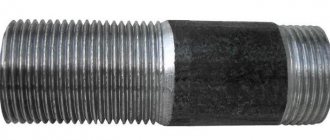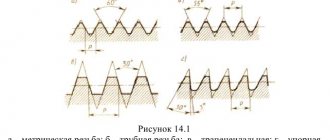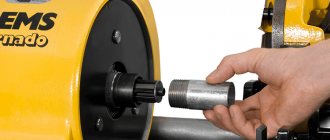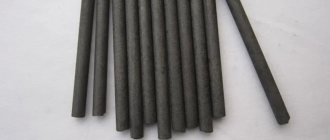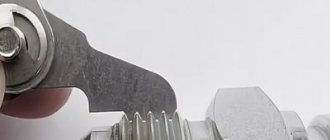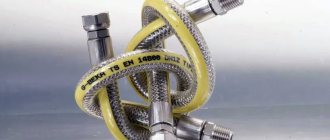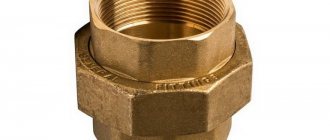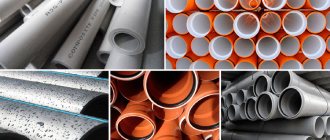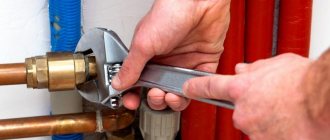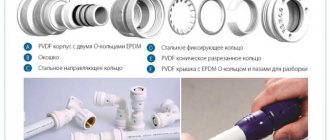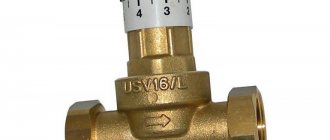For threaded connections of steel pipelines, couplings with internal threads are used, but even if sections of the pipeline fit closely to each other, it will not be possible to connect them with one part (unless it is an American one with a union nut) due to the same thread direction. For these purposes, intermediate sections are used - pipe bends, the dimensions and material of which are regulated by GOST.
When installing a water or gas main from metal pipes yourself, you will need to connect the pipelines to plumbing fixtures or gas equipment. For safe and correct installation of the system, it is useful to know the basic dimensions, materials and methods of manufacturing this element of plumbing fixtures.
Fig. 1 Squeegees for pipes in heating systems, water supply and gas pipelines
Self-production of the squeegee
If necessary, you can make a squeegee of the required size yourself. To complete the work you will need:
- metal steel pipe - a pipe cut of the appropriate length;
- carpenter's vice to make work easier;
- equipment for thread cutting: a die with a die holder for external threads or a tap for applying internal threads;
- file (intended for chamfering);
- grinder (metal hacksaw) for cutting, if you need to cut off a part of the pipe to prepare a pipe;
- lubricant
The work is performed in the following order:
- using a grinder or a hacksaw, the workpiece is cut to the appropriate length;
Cutting a pipe with a grinder to make a bend
In accordance with the recommendations of experts, the length of the run should be 3 - 5 mm longer than the pipe break.
- the ends of the prepared cut are chamfered;
- the edges are treated with lubricant to facilitate thread cutting;
- the squeegee is clamped with a vice;
- The thread is cut using the selected equipment. The short part of the thread must be at least 5 threads, and the long part - 20 threads. If necessary, the long part can be increased to 30 threads.
Thread cutting on the bend
When making your own squeegee, you must not forget about the personal protective equipment of the master. It is recommended to use gloves and a face mask when cutting pipes.
Purpose
The method of connecting pipeline elements depends on several factors, for example, the material of the pipes, the type of transported substance, as well as the conditions of the working environment. The main purpose of pipe fittings is to connect them to plumbing or gas appliances. Welding is not suitable here, because the connection must be detachable: if necessary, some element may have to be dismantled. For example, it is recommended to use squeegees in heating networks after the valve on the riser.
In the event of a breakdown, the presence of a squeegee will make it easy to get the shut-off valve element to repair or replace it. Squeegees are also useful for old cast iron radiators; their presence will help clean the pipeline. This element is used to connect various heating equipment: tanks and gas boilers, as well as mixers. In the kitchen, the squeegee is useful when connecting the stove. Finally, it can be used to create an additional pipeline branch.
Where are squeegees used and installed?
Squeegees are used in water supply systems, heating systems, gas pipelines, they are installed:
- In water supply and heating lines after the valve on the riser. This allows the shut-off valves to be removed from the pipeline in the event of a malfunction for repair or replacement.
- When connecting old-style cast iron pipes to a heating radiator, their use also allows you to clean the pipeline from lime deposits and rust.
- For the supply line when connecting autonomous equipment for heating water - gas boilers, boilers, expansion tanks and plumbing fittings (faucets with a herringbone connector).
- On the pipeline for supplying gas to household and water heating equipment - stoves, boilers.
- Sometimes surges are used in sections of the system to obtain additional outlet, while the coupling is replaced with a tee, and the distance between the pipes is increased.
How to choose a squeegee
When choosing a drive, you need to consider:
- type of connecting fitting;
- fitting material;
- technical specifications.
Types of surges
Surges can be classified according to the following criteria:
- Depending on the design, they are distinguished:
- direct drive, intended for installation on a flat section of the highway (figure above);
- corner bend, intended for areas where it is necessary to change the direction of the pipeline system;
Fitting for changing the direction of the line
Straight and angular bends differ solely in appearance and purpose. All other parameters are completely identical.
- depending on the scope of application there are:
- compensating surges. In most cases, such devices are installed in places where plumbing or gas equipment and heating radiators are connected, as they allow compensation for pipe deviations within 5 cm;
- short and long runs used to connect other equipment of the pipeline system.
Types of pipe runs
Many people, especially novice plumbers, consider fittings such as barrels and threads to be types of fittings. However, this statement is wrong.
A barrel is a piece of pipe with threads at the ends. Unlike a bend, threads of the same length and size are applied to the pipe on both sides. This device is intended for connecting pipes without welding.
Fitting for connecting pipes to each other
A thread is a fitting made from a section of pipe with a thread on one end. The device is used to connect other types of threaded fittings to a water supply, gas or heating system.
Device for installing threaded fittings
Selection of manufacturing materials
For the manufacture of squeegees, the following materials are used:
- carbon steel. Steel fittings are characterized by low cost and a large margin of safety. However, due to their strong susceptibility to corrosion, their installation is carried out mainly on gas supply systems;
- Cink Steel. Such fittings are not subject to the formation of a corrosive coating, therefore they can be used in water supply systems, including drinking water supply and heating, as well as on other pipelines in places subject to possible exposure to precipitation;
- stainless steel. Unlike galvanized stainless steel fittings, they are more expensive and are primarily intended for drinking water supply systems, as well as for connecting pipes in the ground;
- brass. Currently, due to its high cost, it is practically not used.
Brass squeegee for pipelines
Determination of technical parameters
Metal bends are manufactured in accordance with GOST 8969-2010. When selecting parameters, you should consider:
- type of thread. The bends can be with left-hand thread or right-hand thread, with internal thread or with external thread. The selection of this parameter is carried out based on the data of the equipment that needs to be connected using a fitting;
- nominal diameter of the fitting in accordance with the diameter of the pipeline;
- the size of the thread applied to the fitting.
Standard dimensions of metal pipes in accordance with GOST
All technical parameters are indicated in the fitting marking, which is applied in accordance with GOST 8969-75. For example, Sgon40-Ts GOST 8969-75 indicates that the fitting is made of galvanized steel (Ts) in accordance with technical regulations and has a nominal bore of 40 mm.
First meeting
Among plumbers, a squeegee is called:
- A pipe with a short (5 threads) pipe thread at one end and a long (at least 20 threads) pipe thread at the other;
- A long thread cut into the connection to the plumbing fixture.
The sweep allows you to disassemble a section of the pipeline in places where non-rotating parts are connected. Its use where the part can be unscrewed from the coupling fitting is impractical: the more threaded connections, the greater the likelihood of leaks.
The dimensions of pipe bends always correspond to the size of the pipeline into which it is installed. When installing water supply and heating systems, the following nominal dimensions are used:
- DN15 (1/2 inch);
- DN 20 (3/4 inch);
- DN 25 (1 inch);
- DN 32 (1 1/4 inches);
- DN 40 (1 1/2 inches);
- DN 50 (2 inches).
The maximum size is DN50.
Pipelines of large diameters, where the connection needs to be made dismountable, are mounted on flanges.
Standard fitting lengths are specified in GOST 6357-73:
| DU | Length, mm |
| 15 | 110 |
| 20 | 110 |
| 25 | 130 |
| 32 | 130 |
| 40 | 150 |
| 50 | 160 |
Alas, in practice, the lengths of the bends on the connections and risers often differ from the standard ones. In each specific case, they need to be measured and the product of the required length selected.
Installation of squeegees
The main advantages of installing squeegees are:
- ease of installation. Connecting pipes with a bend does not require a welding machine or skills to work with it. The work can be done by a novice craftsman;
- low cost;
- obtaining a detachable connection;
- the ability to carry out repairs without shutting down the entire pipeline.
Fitting locations
It is recommended to install the drives:
- after taps and/or valves, which will allow the subsequent section of the pipeline system to be disconnected for repair or maintenance work;
- on the central risers of any system;
- when connecting equipment (heating radiators, boilers, individual metering devices, and so on);
- on stationary type connections.
Places where installation of the squeegee is required
Fitting installation
To install the pipeline, you will need to purchase a fitting with a coupling and a lock nut (standard fitting kit).
Fitting kit "Sgon"
The connection of the drives with a coupling is carried out according to the following scheme:
- a lock nut is installed on the end of the long thread, and then the coupling is screwed on;
- sections of the pipeline system are connected;
- the coupling smoothly moves along a short section of the thread until it stops (“jamming”, as professional plumbers prepare);
- a long section of thread is sealed in any way: you can use ordinary linen thread with additional fixation with paint or a special compound; You can use specialized products, such as FUM tape, Tangit Unilok thread, and so on;
Threaded connection sealing options
- the coupling is secured with a locknut;
- all assembly elements of the connection are fixed using a gas wrench;
Sequence of pipeline assembly using bends
- The tightness of the resulting connection is checked. If there is a leak through the fitting, it is recommended to increase the amount of sealing material and tighten the nut more tightly.
What is a squeegee and how to install it, watch the video.
Standard flows can be installed on pipeline systems subject to the following conditions:
- the maximum pressure inside the line does not exceed 16 atmospheres;
- maximum temperature of the working environment is 175°C.
If it is necessary to install squeegees on systems with other parameters, it is necessary to manufacture squeegees according to individual parameters.
Pipeline assembly technology
To assemble the pipeline, you must perform the following sequence of actions:
- First, screw the coupling onto the pipe.
- Then the side with the short thread is screwed into the coupling (sometimes it is connected directly). The parts should be screwed all the way, then the connection will be reliable.
- A locknut is screwed onto the long side of the drive.
- Next comes the connecting fitting.
- Then the end of the drive is applied to the pipe and the coupling is screwed together so that it goes onto the pipe. The connection will be easier to complete if the axes of the parts coincide as much as possible.
- The fitting must then be secured with a locknut. To do this, it should be screwed to the coupling so that there is a distance of 2-3 cm between the parts. This space must be filled with strands of flax. They should be wound in the direction of rotation of the nut. Then the locknut should be tightened until it stops. This must be done to seal the connection and prevent water leakage through it. You should use a wrench to tighten the locknut because its edges are narrow.
Pipe bends dimensions according to GOST
A squeegee is a piece of pipe with a double-sided thread of different lengths, its average size on the short side is 5 threads, the long side has a length of at least 20 turns. Metal or galvanized leads with a short thread end are connected to equipment (gas stoves, heating radiators, boilers), and a coupling of the appropriate length and a lock nut move along the long thread. When joining, a long coupling with a sealing seal (linen tow, plumbing thread, FUM tape) is screwed onto another pipe; on the other side of the coupling, the wound seal is pressed with a lock nut.
The parameters of the bends are regulated by GOST 8969-75, which indicates their size, the length of the threaded sections, and the thread diameter in inches.
Rice. 2 Squeegee - appearance and materials of manufacture
Connection device to the outlet and its designation
Steel couplings with or without zinc coating, having double-sided threads, are intended for connecting water and gas pipes in heating systems, gas pipelines, water pipelines and other lines with a non-aggressive working fluid at temperatures up to +175 C. and pressure less than 1, 6 MPa. (16 atm. or bar.). To connect the pipeline with plumbing and gas equipment, the fitting includes a coupling (has lateral longitudinal ribs for engagement with a gas wrench) and a lock nut with standard dimensions corresponding to the external pipe thread of the fitting in accordance with GOST 8969-75.
The fitting marking according to GOST 8969-75 includes the name of the part (squeeze), nominal diameter, material of manufacture (letter C for galvanized steel) and an indication of the above standard. An example of marking is Sgon 25-Ts GOST 8969-75.
Rice. 4 Installation of the drive
How to install the flow into the system
Steel connecting couplings for installation and installation of water pipelines installed after valves are installed in compliance with the following rules:
- Fittings must have a clearance length between pipes of no more than 5 mm. taking into account the recess of the side with a short thread into the connected equipment or fittings.
- On the side with a thread of at least 20 threads in length, a steel lock nut and a coupling are screwed in succession.
- Flax fiber or thread is wound along the thread
- When installing, flax fiber is wound on the short side, lubricated with a special paste, and the drive pipe is screwed into the outlet pipe of the valve manually, and then pressed with a gas wrench. For convenience, use a second key to hold the valve body with it to avoid turning on the pipeline.
Rice. 5 Steel connecting parts according to GOST 8965-75
- Screw the connecting parts onto the long side: the locknut until it stops and the coupling; flax is wound onto the connected pipe along the thread.
- Drive the long coupling down and screw it onto the pipe, pressing it with a gas wrench.
- Wind flax fiber from the other end of the coupling, coat it with paste and tighten the locknut.
Application
Examples
Where can you find sgons?
- After valves on steel connections, water supply and heating risers. They provide the ability to replace shut-off valves if they malfunction. In addition, thanks to the sweep, the pipe can be opened for cleaning (alas, steel pipes over decades of use become overgrown with rust and lime deposits);
- On connections to heating devices. First of all, to the already mentioned cast iron batteries: modern radiators are often mounted on other quick-release fittings - American ones;
Squeegees on the connections to the cast iron radiator.
- On rigid connections to herringbone faucets (old-style kitchen faucets).
Installation
Here are instructions for installing a squeegee using the example of a water supply after a valve.
- The length of the fitting is selected so that it is 3 - 5 mm shorter than the clearance in the pipe, taking into account the threads in the valve body;
- A locknut and coupling are screwed sequentially onto the long thread of the drive;
- A short thread is wound along the thread;
I use Tangit Unilok sealing thread or sanitary flax as a winding with mandatory impregnation with any paint or varnish. Impregnation will prevent organic fiber from rotting in cold water and burning out in hot water supply or heating.
The photo shows Tangit Unilok sealant thread.
- The liner is pulled or pushed a couple of centimeters to the side, and the squeegee is screwed into the thread of the valve. At first - with your own hands, without tools, then it is tightened with a gas wrench. It is advisable to hold the valve body with a second key, not allowing it to turn : the new position of the thumb or handle may be inconvenient, and the reverse movement of the thread will most likely cause it to leak;
- The short thread on the connection after the valve is wound up, after which the coupling from the long thread is driven onto it;
Captain Obviousness suggests: the term “drive” came from here.
- The locknut is driven along the thread following the coupling until 3-4 threads remain between them;
- A winding is placed into the gap along the thread, after which the locknut is tightened.
Connection assembly procedure. 1-squeeze, 2-connection, 3-coupling, 4—lock nut.
A little trick: by installing a tee instead of a coupling, you can get an additional cold water or hot water outlet (for example, to connect a washing machine or dishwasher).
Recommendations for dismantling
To prevent rust from occurring on gas and water pipes, they must be painted. The service life of the pipeline after painting will increase, however, after this, dismantling the threaded connections becomes quite difficult. For this reason, you should not paint the threaded area several times; one coat is enough. To make disassembly easier, these areas should be coated with grease.
If the connections on the section of the pipeline to be disassembled have been painted several times, then it is necessary to first remove the paint layer. To do this, you can use a blowtorch or a knife.
The material from which the fitting is made affects the complexity of dismantling. For example, ductile cast iron parts screwed onto steel pipes will not be difficult to unscrew with a wrench. Such parts practically do not “grow together” with the pipes. But it is impossible to unscrew a steel coupling with a wrench.
The key should not be reinforced with a lever, otherwise it will be damaged and the part will remain unscrewed.
Conclusion
So, we found out that this is a pipeline bend and a coupling. Using these parts, a collapsible pipeline connection is created. The use of a sweep makes it possible to dismantle a certain section of the system without the need to disassemble the entire pipeline in the event of repair work.
In this article I want to introduce the reader to one of the simplest fittings for installing steel water pipes - a fitting. We will find out what it is and find out how and where the squeegee is installed. In addition, we will get acquainted with the typical problems of connections with squeegees and how to eliminate them.
Let me introduce the hero of this article.
Problems and solutions
Here is a description of several common connection problems on spigots and how to solve them.
Lock nut leaking on water supply line
The cause of a leak is most often a rotten or burnt-out winding.
Plumbing linen without impregnation is not resistant to moisture and high temperatures.
Any quick-drying varnishes and paints can be used as impregnation.
The problem is resolved as follows:
- Close the valve on the corresponding water;
- We open the tap to make sure that the valve is working and to relieve excess pressure in the supply;
- While holding the drive from turning with one gas wrench, use the second to unscrew the lock nut 3-4 turns;
- We remove the old winding from the gap between the locknut and the coupling and wind the strand with a new one;
- Tighten the locknut and check the pressure line.
The locknut on the radiator connection is leaking
In addition to winding burnout, there are a couple more probable causes of the malfunction:
- Mobility of the radiator or liner to it. This is why batteries leak so often in hallways, where they are often touched or used instead of benches in the process of friendly communication;
- Deviation of the thread axis in a locknut from perpendicular to its plane. In this case, any winding will leak after 2 - 4 weeks of operation.
The locknut on the radiator connection is leaking. The squeegee is used as a jumper.
Rewinding the locknut is carried out in the same way as on the water supply line, but with one caveat: the heating riser must be securely disconnected. It is not necessary to reset it - in this case you will have to bleed the air again on the upper floor, but it is absolutely necessary to close the valve on the riser. Otherwise, you risk flooding your apartment and getting serious burns.
Replacing a locknut with a properly threaded fitting is a bit more difficult.
If soon after rewinding the locknut leaks again, it needs to be replaced.
- We reset the paired heating risers;
I'm talking about the most common scheme with bottom heating. In houses with top filling, one riser is turned off and reset. Vents and vents are located in the basement and attic.
Bottom filling: heating supply and return are located in the basement, risers are connected in pairs by jumpers on the upper floor.
- We drive the locknut along the thread;
- We clean the thread from remnants of winding;
- We unscrew and thread the radiator cap. On radiators with one-sided side connections, the threads in the through plugs are always normal, right-handed. To unscrew it, you will need a gas key No. 3 - No. 4;
- We remove the liner from the radiator. If the lower connection is disassembled, you will have to remove the radiator itself from the mount and move it away from the riser. The top line is usually removed from the battery due to the flexibility of the riser pipe;
In some cases, you have to disconnect both connections.
- We drive the plug and locknut along the long thread of the drive;
- We replace the locknut with a new one;
- We assemble the eyeliner in reverse order. To wind the radiator cap, use flax with paint: it will take too much polymer thread;
- We start the heating riser;
We bleed the air on the top floor (in the case of a lower filling house) or in the expansion tank in the attic (for a top filling house).
Mayevsky tap on a radiator in an apartment on the top floor.
Thread leakage
The long thread of the outlet is the most vulnerable point of steel water supply and heating connections. In the vast majority of cases, the first leaks during long-term operation of the pipeline appear precisely there. There are two reasons:
- At the thread cavities, the pipe walls have a minimum thickness;
- Disassembling the squeegee inevitably damages the paint coating that protects the steel from corrosion.
When there is a leak in the thread, the flow changes.
Squeegees with rusted threads must be replaced immediately.
Installing a brass squeegee will help solve the problem of corrosion once and for all . Finished products of the most popular sizes can be found in any plumbing store. Their price is 3-4 times higher than that of steel ones, but the difference is more than covered by their almost unlimited service life.
The brass squeegee does not rust and does not become overgrown with deposits. The cost for a diameter of 1/2 inch is about 130 rubles.
Self-production
Typically, bends are made of steel, mainly galvanized. If the element is installed on an individual water supply system, from which water suitable for drinking comes from, then preference is given to brass and stainless steel. Experts note that stainless steel squeegees have the longest service life. They assure that this material will last four times longer than carbon steel and twice as long as galvanized steel.
The squeegee can also be made from bronze, copper and cast iron tubes. Depending on the selected material, the possible operating conditions, service life, and cost of the product will be determined. For example, a copper strip will not be subject to temperature fluctuations and ultraviolet radiation. As for the price, one of the cheapest options is an aluminum element. You will have to pay twice as much for a zinc part, three times as much for a stainless steel fitting.
It is quite possible to make the drive yourself. Sometimes this is done to save time and money, and sometimes to compensate for the lack of a part of the required length in the store. Usually, only the tube is made independently, and the coupling and locknut are taken from another kit. When choosing a suitable material, remember that the pipe must have walls of considerable thickness.
Let's look at the algorithm for making a squeegee at home.
First of all, a blank of the required length is cut from a gas pipe of the required size. Having clamped the part in a vice, both ends of the pipe are processed using a grinder, sandpaper or hacksaw. It is recommended to pre-lubricate the surface with oil; its use will greatly simplify the process. Next, threads need to be cut on both sides: 20 on one side and 5-6 on the other. This is done by screwing a die with a guide frame into the pipe, and initially you will have to apply maximum force, and then everything will go by itself. You can stop pressing the die after the first two turns
Cutting is done both forward and backward. It is important not to forget to periodically remove the tool and clean both it and the pipe from chips. After the initial cutting, it will be necessary to carry out another, finishing one.
For information on how to install a squeegee on pipes, see the video below.
Is it possible to make a squeegee yourself and how to do it?
When installing a pipeline with your own hands, sometimes a situation arises when you need to select the required length of pipes - factory products, according to standards, cover only a narrow range of sizes and diameters. In this case, a self-made pipe is used, and the clamping locknut and coupling of the required diameter are taken from another workpiece. For manufacturing, you need to use a piece of gas pipe of suitable length; to carry out the work, you will need a die with a holder or clamp, oil, a vice for clamping the workpiece, a hacksaw for metal or a grinder for cutting the pipe.
Rice. 7 Example of installation of a squeegee on a FUM tape for installing a gas meter
The work is carried out in the following sequence:
- Cut a piece of the required length from the pipe, clamp the part in a vice, protect the outer ends on both sides with sandpaper, a grinder or a file.
- Lubricate the pipe surface on the side of the short thread, insert a die into the holder or die and press it tightly against the end, trying to maintain a strictly perpendicular position relative to the axis of the workpiece.
- They begin to screw the die into the pipe, applying maximum force; after several turns and the teeth of the die grab the thread, no clamping force is required.
- Cutting is carried out in the forward and reverse directions, periodically removing the tool and cleaning it from chips with a clean rag along with the pipe surface.
- After passing 5 - 6 turns on the short side, the part is turned over and they begin cutting a long thread of 20 turns on the other end.
Rice. 8 The procedure for making a squeegee with your own hands
Squeegee is one of the most common options for connecting steel pipelines to plumbing and gas fittings and equipment. When installed correctly, the coupling provides a reliable, durable and tight connection; if necessary, it is easy to make a fitting of a suitable length with your own hands.
